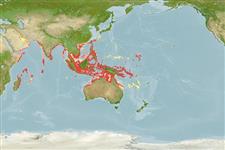Common names from other countries
分类 / Names
俗名 | 同种异名 | Catalog of Fishes(属, 种) | ITIS | CoL | WoRMS | Cloffa
Teleostei >
Clupeiformes (Herrings) >
Dorosomatidae (Gizzard shads and sardinellas)
Etymology: Anodontostoma: Greek, ana = up + Greek, odous = teeth + Greek, stoma = mouth (Ref. 45335).
More on author: Hamilton.
Environment: milieu / climate zone / depth range / distribution range
生态学
海洋; 淡水; 半咸淡水; 溯河洄游 (Ref. 51243); 深度上下限 0 - 50 m (Ref. 188). 热带; 31°N - 23°S, 47°E - 171°E (Ref. 188)
Indo-West Pacific: Persian Gulf to coasts of India and Andaman Sea, to Gulf of Thailand, Indonesia, Viet Nam, and Philippines, south to northern Australia, the Caroline Islands and New Caledonia.
印度-西太平洋: 到泰国湾,印度尼西亚,越南与菲律宾的波斯湾到印度海岸与安达曼海南至澳洲北部,加罗林群岛与新加勒多尼亚。
Length at first maturity / 大小 / 重量 / 年龄
Maturity: Lm 14.1 range ? - ? cm
Max length : 22.0 cm SL 雄鱼/尚未辨别雌雄; (Ref. 54980); common length : 14.0 cm SL 雄鱼/尚未辨别雌雄; (Ref. 3107)
背棘 (总数) : 0; 臀棘: 0; 臀鳍软条: 17 - 25. Body depth increasing with size of fish, 40 to 70 % standard length in fishes over 10 cm. Second supra-maxilla a mere splint. Longest gill rakers on lower part of arch less than corresponding gill filaments. Hind edges of scales toothed, the teeth thinner than the gaps between them; a median series of pre-dorsal scales. A large black spot behind gill opening.
体高随着鱼的大小增加,40 到 70% 在超过 10 公分的鱼中标准长度。 第二个上颚骨一个仅仅夹板。 在弓的较下面的部位上的长的鳃耙少于对应的鳃丝。 鳞片的后缘有齿的, 超过在他们之间的间隙齿稀释剂; 一个中央的成列前背部的鳞片。 在鳃裂后面的一个大的黑色斑点。
Pelagic inshore (Ref. 68964). Usually marine coastal, but ascends rivers to the upper tidal zone (Ref. 12693). Occurs inshore and also in estuaries. Feeds on diatoms, radiolarians, mollusks, copepods, and crustaceans (in that order of importance, at least in the Godavari estuary). Breeds from November to February, mainly in the later part (Godavari estuary). Marketed fresh, frozen, dried, dried-salted or boiled. Made into fish balls.
通常海洋的海岸, 但是溯河到上面的潮间带.(参考文献 12693) 生活于近海以及在河口。 吃硅藻,放射虫类,软件动物,桡脚类的动物与甲壳动物。 (依重要性排列, 至少在 Godavari 河口) 繁殖从十一月到二月, 主要在该期间的后段 (Godavari 河口). 在市场上销售新鲜的,冷冻的, 乾制, 乾燥盐腌或煮沸的。 制成了鱼丸。
印度-西太平洋: 到泰国湾,印度尼西亚,越南与菲律宾的波斯湾到印度海岸与安达曼海南至澳洲北部,加罗林群岛与新加勒多尼亚。
Whitehead, P.J.P., 1985. FAO Species Catalogue. Vol. 7. Clupeoid fishes of the world (suborder Clupeoidei). An annotated and illustrated catalogue of the herrings, sardines, pilchards, sprats, shads, anchovies and wolf-herrings. FAO Fish. Synop. 125(7/1):1-303. Rome: FAO. (Ref. 188)
CITES (Ref. 128078)
Not Evaluated
人类利用
渔业: 商业性
工具
特别资料
下载 XML
网络资源
Estimates based on models
Preferred temperature (Ref.
115969): 26.5 - 29.1, mean 28.3 (based on 1250 cells).
Phylogenetic diversity index (Ref.
82804): PD
50 = 0.6250 [Uniqueness, from 0.5 = low to 2.0 = high].
Bayesian length-weight: a=0.00933 (0.00810 - 0.01075), b=3.04 (3.00 - 3.08), in cm Total Length, based on LWR estimates for this species (Ref.
93245).
营养阶层 (Ref.
69278): 2.8 ±0.28 se; based on food items.
回复力 (Ref.
120179): 高度, 族群倍增时间少于 15个月 (K=0.9-1.3).
Prior r = 1.19, 95% CL = 0.79 - 1.79, Based on 4 data-limited stock assessments.
Fishing Vulnerability (Ref.
59153): Low vulnerability (14 of 100).
Climate Vulnerability (Ref.
125649): Moderate to high vulnerability (51 of 100).
